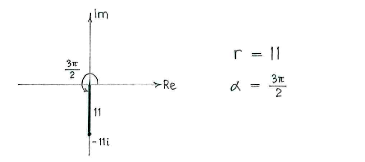Lösung 3.2:6b
Aus Online Mathematik Brückenkurs 2
(Unterschied zwischen Versionen)
K |
|||
| Zeile 1: | Zeile 1: | ||
| - | If we determine the number's magnitude | + | If we determine the number's magnitude <math>r</math> and argument <math>\alpha </math>, we can write its polar form using the formula |
| - | <math>r</math> | + | |
| - | and argument | + | |
| - | <math>\alpha </math>, we can write its polar form using the formula | + | |
| + | {{Displayed math||<math>r(\cos\alpha + i\sin\alpha)\,\textrm{.}</math>}} | ||
| - | + | Because the number lies on the imaginary axis, it is possible to write its magnitude and argument directly. | |
| - | + | ||
| - | + | ||
| - | Because the number lies on the imaginary axis, it is possible to write its magnitude and argument directly | + | |
| - | + | ||
[[Image:3_2_6_b.gif|center]] | [[Image:3_2_6_b.gif|center]] | ||
| - | |||
The polar form is | The polar form is | ||
| - | + | {{Displayed math||<math>11\Bigl(\cos\frac{3\pi}{2} + i\sin\frac{3\pi}{2}\Bigr)\,\textrm{.}</math>}} | |
| - | <math>11\ | + | |
Version vom 13:14, 29. Okt. 2008
If we determine the number's magnitude \displaystyle r and argument \displaystyle \alpha , we can write its polar form using the formula
| \displaystyle r(\cos\alpha + i\sin\alpha)\,\textrm{.} |
Because the number lies on the imaginary axis, it is possible to write its magnitude and argument directly.
The polar form is
| \displaystyle 11\Bigl(\cos\frac{3\pi}{2} + i\sin\frac{3\pi}{2}\Bigr)\,\textrm{.} |

